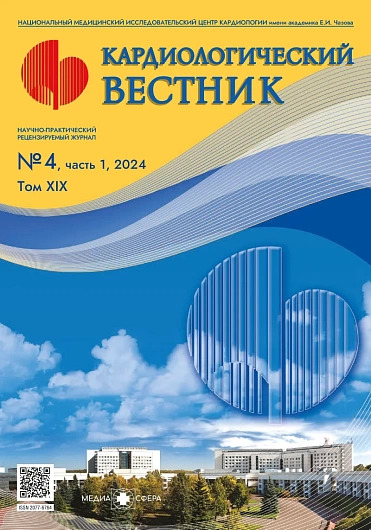Non-fluoroscopic ablation of supraventricular tachycardia — results of a new approach
Abstract
Objective. To evaluate the efficacy and safety of catheter ablation of supraventricular tachycardia (SVT) using exclusively intracardiac ultrasound compared to conventional fluoroscopic approach.
Material and methods. There were 170 patients with SVT (85 patients in each group): 128 ones with atrioventricular nodal reentry tachycardia (AVNRT) and 42 ones with atrioventricular re-entry tachycardia (AVRT). In the non-fluoroscopic group, ablation
was performed under intracardiac ultrasound guidance. The follow-up period was 12 months.
Results. Intraoperative success rate was 100% in both groups. Freedom from recurrence was comparable among patients with
AVNRT (90.6% vs. 93.75%, p=0.74) and AVRT (95.2% vs. 95.2%). Safety of procedures was also similar (AVNRT 4.7% vs. 0%,
p=0.24; AVRT 0% vs. 0%). Fluoroscopy was used in none patient who underwent the procedure under intracardiac ultrasound
guidance (p < 0.001). However, surgery time and overall RF-ablation time was significantly shorter in the non-fluoroscopic group
among patients with AVNRT.
Conclusion. Catheter ablation of SVT under intracardiac ultrasound control is possible without fluoroscopy and electrophysiological navigation. This procedure is effective and safe.
References
Сапельников О. В., Ардус Д. Ф., Костин В. С., и др. Нефлюороскопический подход к катетерному лечению фибрилляции предсердий. Российский кардиологический журнал. 2020; 25(12):3928. https://doi.org/10.15829/1560-4071-2020-3928 Sapelnikov O.V., Ardus D.F., Kostin V.S., Uskach T.M., Cherkashin D.I., Grishin I.R., Bogatyreva K.B., Emelyanov A.V., Kulikov A.A., Nikolaeva O.A., Akchurin R.S. Nonfluoroscopic catheter ablation in patients with atrial fibrillation. Russian Journal of Cardiology. 2020;25(12):3928. (In Russ.) https://doi.org/10.15829/1560-4071-2020-3928
Костин В.С., Сапельников О.В., Ускач Т.М., и др. Нефлюороскопический подход к криобаллонной аблации фибрилляции предсердий. (Результаты годового наблюдения). Кардиологический вестник. 2021;16(4):4957. Kostin VS, Sapelnikov OV, Uskach TM, et al. Non-fluoroscopic approach to cryoballoon ablation for atrial fibrillation. (1 year follow-up results). Russian Cardiology Bulletin. 2021;16(4):4957. (In Russ.) https://doi.org/10.17116/Cardiobulletin20211604149
Гусейнли Э.Г., Сапельников О.В., Аманатова В.А., и др. Непосредственная эффективность и безопасность нефлюороскопического подхода в катетерном лечении желудочковых тахикардий. Кардиология. 2023;63(3):36-45. https://doi.org/10.18087/cardio.2023.3.n2243 Huseynli E.G., Sapelnikov O.V., Amanatova V.A., Ardus D.F., Khachirov M.R., Grishin I.R., Cherkashin D.I., Saidova M.A., Stukalova O.V., Shlevkov N.B., Uskach T.M., Akchurin R.S. Efficacy and Safety of Nonfluoroscopic Approach During Catheter Ablation of Ventricular Tachycardias. Kardiologiia. 2023;63(3):36-45. https://doi.org/10.18087/cardio.2023.3.n2243
Troisi F, Guida P, Quadrini F, et al. Zero Fluoroscopy Arrhythmias Catheter Ablation: A Trend Toward More Frequent Practice in a High-Volume Center. Front Cardiovasc Med. 2022; 9:804424. https://doi.org/10.3389/fcvm.2022.804424
Debreceni D, Janosi K, Vamos M, et al. Zero and Minimal Fluoroscopic Approaches During Ablation of Supraventricular Tachycardias: A Systematic Review and Meta-Analysis. Front Cardiovasc Med. 2022; 9:856145. https://doi.org/10.3389/fcvm.2022.856145
Enriquez A, Saenz LC, Rosso R, et al. Use of Intracardiac Echocardiography in Interventional Cardiology: Working With the Anatomy Rather Than Fighting It. Circulation. 2018; 137(21):2278-2294. https://doi.org/10.1161/CIRCULATIONAHA.117.031343
Luani B, Zrenner B, Basho M, et al. Zero-fluoroscopy cryothermal ablation of atrioventricular nodal re-entry tachycardia guided by endovascular and endocardial catheter visualization using intracardiac echocardiography (Ice&ICE Trial). J Cardiovasc Electrophysiol. 2018; 29(1):160-166. https://doi.org/10.1111/jce.13354
Luani B, Rauwolf T, Genz C, Schmeißer A, Wiemer M, Braun-Dullaeus RC. Intracardiac echocardiography versus fluoroscopy for endovascular and endocardial catheter navigation during cryo-ablation of the slow pathway in AVNRT patients. Cardiovasc Ultrasound. 2019; 17(1):12. https://doi.org/10.1186/s12947-019-0162-2
Luani B, Basho M, Ismail A, et al. Catheter navigation by intracardiac echocardiography enables zero-fluoroscopy linear lesion formation and bidirectional cavotricuspid isthmus block in patients with typical atrial flutter. Cardiovasc Ultrasound. 2023; 21(1):13. https://doi.org/10.1186/s12947-023-00312-w
Debreceni D, Janosi KF, Turcsan M, et al. Feasibility and safety of cavotricuspid isthmus ablation using exclusive intracardiac echocardiography guidance: a proof-of-concept, observational trial. Front Cardiovasc Med. 2023; 10:1244137. https://doi.org/10.3389/fcvm.2023.1244137
Prolič Kalinšek T, Šorli J, Jan M, et al. Conventional fluoroscopy-guided versus zero-fluoroscopy catheter ablation of supraventricular tachycardias. BMC Cardiovasc Disord. 2022; 22(1):98. https://doi.org/10.1186/s12872-022-02544-6
Lehar F, Szegedi N, Hejc J, et al. Randomized comparison of atrioventricular node re-entry tachycardia and atrial flutter catheter ablation with and without fluoroscopic guidance: ZeroFluoro study [published correction appears in Europace]. 2023 Oct 5; 25(10):euad311. https://doi.org/10.1093/europace/euac049
Bergonti M, Dello Russo A, Sicuso R, et al. Long-Term Outcomes of Near-Zero Radiation Ablation of Paroxysmal Supraventricular Tachycardia: A Comparison With Fluoroscopy-Guided Approach. JACC Clin Electrophysiol. 2021; 7(9):1108-1117. https://doi.org/10.1016/j.jacep.2021.02.017
Razminia M, Willoughby MC, Demo H, et al. Fluoroless Catheter Ablation of Cardiac Arrhythmias: A 5-Year Experience. Pacing Clin Electrophysiol. 2017; 40(4):425-433. https://doi.org/10.1111/pace.13038
Jan M, Yazici M, Kalinšek TP, et al. Fluoroless radiofrequency and cryoablation of atrioventricular nodal reentry tachycardia in adults and children: a single-center experience. J Interv Card Electrophysiol. 2021; 61(1):155-163. https://doi.org/10.1007/s10840-020-00791-1

